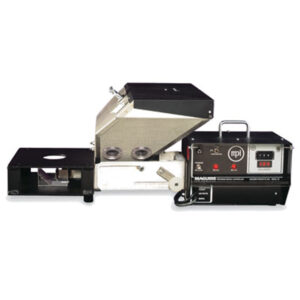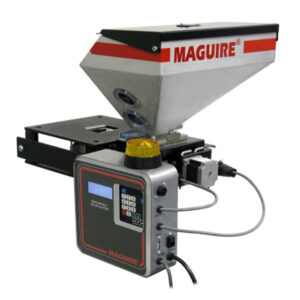Improves Control of Vented Screw
When used in conjunction with a vented screw – the MSF starve feeder allows the operator to regulate the feed to the rear portion of the screw. If the front portion of the screw is unable to extrude plastic as rapidly as the rear portion, then the excess flow from the rear will be forced out the vent. This condition could result from:
- The use of back pressure during screw return time.
- Worn screw flights in the forward zone.
- Intentionally unbalanced temperatures over the length of the barrel, etc.
Use of a starve feeder allows careful regulation over the volume of material that is metered to the rear feed section of the screw, thus allowing an operator to override the tendency for material to escape from the vent.
Improves Material Processing
As plastic pellets are heated and plasticized, surface moisture and some volatiles will be driven off as vapor and steam. The vapor and steam that travel backwards will re-condense on the colder pellets in the feed zone and hopper, and then will be carried into the screw over and over again. “Starve feeding” does two things to help remedy this problem. First, a “starved” screw will have a continuous air passage directly behind the spiraling screw flight that will allow vapors to easily escape back through to the feed throat. Second, the starve feeder itself provides a vent to atmosphere so that vapors need not travel up through the cold resin in the hopper.
Reduce Drive Motor Torque
Some granular forms of resin will feed so efficiently at the feed section of the screw that the horsepower or torque available to drive the screw is not sufficient, and the drive motor becomes overloaded. Starve feeding will correct this problem by metering resin at a rate that does not exceed the horsepower or torque of the drive motor.
Control Slippage |
|
|
When the feed zone of a process machine is not cooled, the plastic pellets in the throat may preheat considerably if throughput rate is low and residence time in the throat is too long. This may cause premature melting in the barrel, resulting in screw slippage which will then produce erratic and extended screw return times. Starve feeding eliminates residence time and consequently prevents screw slippage. In these situations, starve feeding actually can produce a shorter screw return time than with “flood” feeding.
|
 |
No Calibration Required
Your operator need only select the “percent” of full flow desired, such as 70 or 80%. The microprocessor will self-calibrate by first matching your molder’s extrusion rate and then automatically cutting back to the selected reduced “starve” rate of feed. No calibration of the system is ever necessary.
Manual Bypass
A hinged flow plate allows conventional flood feed fo manually bypassing the “starve” system..





There are no reviews yet.